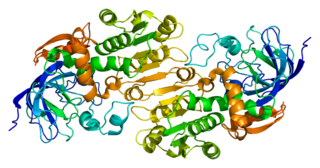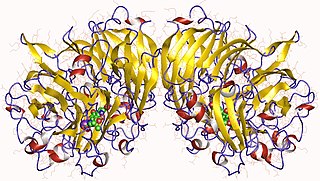
Alcohol dehydrogenases (ADH) (EC 1.1.1.1) are a group of dehydrogenase enzymes that occur in many organisms and facilitate the interconversion between alcohols and aldehydes or ketones with the reduction of nicotinamide adenine dinucleotide (NAD+) to NADH. In humans and many other animals, they serve to break down alcohols that are otherwise toxic, and they also participate in the generation of useful aldehyde, ketone, or alcohol groups during the biosynthesis of various metabolites. In yeast, plants, and many bacteria, some alcohol dehydrogenases catalyze the opposite reaction as part of fermentation to ensure a constant supply of NAD+.

Pyrroloquinoline quinone (PQQ), also called methoxatin, is a redox cofactor and antioxidant. Produced by bacteria, it is found in soil and foods such as kiwifruit, as well as human breast milk. Enzymes using PQQ as a redox cofactor are called quinoproteins and play a variety of redox roles. Quinoprotein glucose dehydrogenase is used as a glucose sensor in bacteria. PQQ stimulates growth in bacteria. Eukaryote targets, including mammalian lactate dehydrogenase, are of more interest to health. It is suggested that PQQ taken as a dietary supplement could promote mitochondrial biogenesis via this pathway as well as PGC-1α.
In enzymology, a cis-2,3-dihydrobiphenyl-2,3-diol dehydrogenase (EC 1.3.1.56) is an enzyme that catalyzes the chemical reaction
In enzymology, a quinoline 2-oxidoreductase (EC 1.3.99.17) is an enzyme that catalyzes the chemical reaction
In enzymology, an alcohol dehydrogenase (acceptor) (EC 1.1.99.8) is an enzyme that catalyzes the chemical reaction
In enzymology, a choline dehydrogenase is an enzyme that catalyzes the chemical reaction
In enzymology, a quinoprotein glucose dehydrogenase is an enzyme that catalyzes the chemical reaction
In enzymology, a mycothiol-dependent formaldehyde dehydrogenase (EC 1.1.1.306) is an enzyme that catalyzes the chemical reaction

In enzymology, a steroid Δ5-isomerase is an enzyme that catalyzes the chemical reaction

Azurin is a small, periplasmic, bacterial blue copper protein found in Pseudomonas, Bordetella, or Alcaligenes bacteria. Azurin moderates single-electron transfer between enzymes associated with the cytochrome chain by undergoing oxidation-reduction between Cu(I) and Cu(II). Each monomer of an azurin tetramer has a molecular weight of approximately 14kDa, contains a single copper atom, is intensively blue, and has a fluorescence emission band centered at 308 nm.

Methanol dehydrogenase (cytochrome c) (EC 1.1.2.7, methanol dehydrogenase, MDH) is an enzyme with systematic name methanol:cytochrome c oxidoreductase. This enzyme catalyses the following chemical reaction
Alcohol dehydrogenase (cytochrome c) (EC 1.1.2.8, type I quinoprotein alcohol dehydrogenase, quinoprotein ethanol dehydrogenase) is an enzyme with systematic name alcohol:cytochrome c oxidoreductase. This enzyme catalyses the following chemical reaction
Alcohol dehydrogenase (quinone) (EC 1.1.5.5, type III ADH, membrane associated quinohaemoprotein alcohol dehydrogenase) is an enzyme with systematic name alcohol:quinone oxidoreductase. This enzyme catalyses the following chemical reaction
Cyclic alcohol dehydrogenase (quinone) (EC 1.1.5.7, cyclic alcohol dehydrogenase, MCAD) is an enzyme with systematic name cyclic alcohol:quinone oxidoreductase. This enzyme catalyses the following chemical reaction
Quinate dehydrogenase (quinone) (EC 1.1.5.8, NAD(P)+-independent quinate dehydrogenase, quinate:pyrroloquinoline-quinone 5-oxidoreductase) is an enzyme with systematic name quinate:quinol 3-oxidoreductase. This enzyme catalyses the following chemical reaction
Soluble quinoprotein glucose dehydrogenase is an enzyme with systematic name D-glucose:acceptor oxidoreductase. This enzyme catalyses the following chemical reaction
Alcohol dehydrogenase (nicotinoprotein) (EC 1.1.99.36, NDMA-dependent alcohol dehydrogenase, nicotinoprotein alcohol dehydrogenase, np-ADH, ethanol:N,N-dimethyl-4-nitrosoaniline oxidoreductase) is an enzyme with systematic name ethanol:acceptor oxidoreductase. This enzyme catalyses the following chemical reaction
Methylamine dehydrogenase (amicyanin) (EC 1.4.9.1, amine dehydrogenase, primary-amine dehydrogenase) is an enzyme with systematic name methylamine:amicyanin oxidoreductase (deaminating). This enzyme catalyses the following chemical reaction:
Aralkylamine dehydrogenase (azurin) (EC 1.4.9.2, aromatic amine dehydrogenase, arylamine dehydrogenase, tyramine dehydrogenase) is an enzyme with the systematic name aralkylamine:azurin oxidoreductase (deaminating). This enzyme catalyses the following chemical reaction:
Lupanine 17-hydroxylase (cytochrome c) (EC 1.17.2.2, lupanine dehydrogenase (cytochrome c)) is an enzyme with systematic name lupanine:cytochrome c-oxidoreductase (17-hydroxylating). This enzyme catalyses the following chemical reaction





